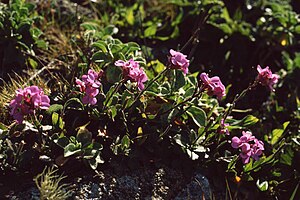Arabis blepharophylla
| Arabis blepharophylla | ||||||||||||
|---|---|---|---|---|---|---|---|---|---|---|---|---|

Arabis blepharophylla |
||||||||||||
| Systematics | ||||||||||||
|
||||||||||||
| Scientific name | ||||||||||||
| Arabis blepharophylla | ||||||||||||
| Hook. & Arn. |
The plant species Arabis blepharophylla from the genus of the rock cress ( Arabis ) belongs to the cruciferous family (Brassicaceae). It occurs naturally only in a few places in California , but is quite common as an ornamental plant.
description
Arabis blepharophylla is a small, perennial herbaceous plant and reaches heights of 6 to 25, rarely up to 30 centimeters. All above-ground parts of the plant are sparsely to moderately hairy; the hair is simple, forked or, less often, star-shaped with three or four rays. One or a few stems emerge from the slightly woody base , which may be unbranched or slightly branched in the upper area. The leaves are partly in a basal rosette, three to six leaves are distributed on the stem. The basal leaves have a 0.5 to 3 centimeter long petiole, the leaf blade is 2.1 to 3.5 centimeters long and 0.8 to 2 centimeters wide (in exceptional cases only 1.5 × 0.5 centimeters or 6 × 2.5 centimeters in size). Their shape is wrong-lanceolate, wrong-egg-shaped or spatulate, the edge is entire or toothed. The stem leaves are 1 to 2 centimeters long and 0.4 to 1 centimeter wide, and their shape is oblong to ovoid.
The flowering period extends from February to May. The terminal, simple, racemose inflorescence is densely covered with flowers . The sepals measure 5 to 7 millimeters in length by 1.5 to 2 millimeters wide. Two of the four sepals have a bulge at the base. The rose-colored to carmine-red petals are spatulate to broadly spatulate, 14 to 18 millimeters long and 4 to 7 millimeters wide, they end bluntly or rounded.
The more or less upright pods are 2 to 4 inches long and 0.2 to 0.3 inches in diameter. The pods are slightly constricted between the seeds. The seeds are more or less circular with a diameter of 2 to 2.5 millimeters and have a circumferential wing that is 0.2 to 0.4 millimeters wide.
The number of chromosomes is 2n = 16.
distribution
Arabis blepharophylla is endemic to the California Coast Mountains in the vicinity of San Francisco . It grows on grassy and stony slopes in more or less steep terrain at altitudes of 30 to 1100 m. It is rated as rare but only slightly endangered.
use
Arabis blepharophylla is occasionally used as an ornamental plant, for example in the dark variety 'Spring Magic'. If it is to be used as a perennial, it is suitable for low-lime rock gardens with fresh, loose soil, but in Central Europe it needs light winter protection. It is more commonly used as a seasonally traded annual herb.
Individual evidence
- ↑ a b c Ihsan A. Al-Shehbaz: Arabis . In Flora of North America Editorial Committee (Ed.): Flora of North America North of Mexico . Volume 7: Magnoliophyta: Salicaceae to Brassicaceae . Oxford University Press, New York / Oxford a. a. 2010, ISBN 978-0-19-531822-7 , pp. 266 (English, limited preview in Google Book search). (on-line).
- ↑ a b c d California Native Plant Society (CNPS): Inventory of Rare and Endangered Plants (online edition, v7-10c). California Native Plant Society. Sacramento, CA. 2010. Accessed online September 16, 2010
- ↑ James C. Hickman (Ed.): The Jepson Manual. Higher Plants of California . University of California Press, Berkeley, Calif 1993, ISBN 0-520-08255-9 . ( online )
- ↑ Richard Hansen , Friedrich Stahl: The perennials and their areas of life . 5th edition. Eugen Ulmer, Stuttgart 1997, ISBN 3-8001-6630-5 , pp. 404 .